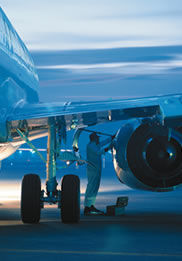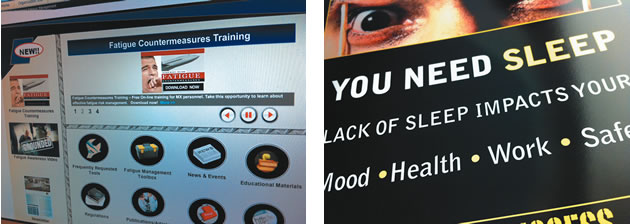

Aviation maintenance technicians (AMTs) often work extended hours and through the night. The result can be a lack of adequate sleep and a fatigued state that can contribute to errors. There is a growing realization that maintenance and engineering organizations should develop their own fatigue risk management systems (FRMS) to deal with these issues.
A fatigue risk management system can help airplane maintenance organizations reduce the hazards associated with fatigued workers.
Numerous studies have highlighted the need for aviation maintenance and engineering organizations to implement an FRMS. The International Civil Aviation Organization and the major national aviation authorities also encourage an FRMS for maintenance workers — some even require this type of system.
This article outlines the need for an FRMS, describes the main elements of an implementation, and provides Web site information where airlines and maintenance, repair, and overhaul (MRO) organizations can access materials to use in their FRMS programs.
The dangers of fatigue
Between 1998 and 2000, the U.S. Federal Aviation Administration (FAA) conducted a significant study on the sleeping habits of AMTs in the United States. The FAA collected some 50,000 hours worth of sleep data using a watchlike accelerometer to determine how long an individual was sleeping. The study concluded that the technicians slept an average of just five hours and five minutes per day compared to the recommended eight hours per day for the average person (Hall, S., Johnson, W. B., and Watson, J. [2001] Evaluation of Aviation Maintenance Working Environments, Fatigue, and Human Performance: Phase III, Washington, D.C.: FAA Office of Aviation Medicine. http://hfskyway.faa.gov).
This lack of sleep is believed to be an important contributor to errors made by AMTs. For example, the Aviation Safety Reporting System — an incident reporting service for pilots, mechanics, and flight attendants in the United States that is administered by the National Aeronautics and Space Administration — included 77 AMT fatigue-related reports from 1990 to 2009. Fatigue contributes to both errors of commission (i.e., the AMT did something, but did it incorrectly) and errors of omission (i.e., the AMT forgot to do something that should have been done) (see fig. 1).
Figure 1: Fatigue-related errors reported to the Aviation Safety Reporting System
| Errors of Commission | Errors of Omission | |
|---|---|---|
| Damaged ram air turbine blade on functional test. | Taxiing airplane and forgot to stop at an active runway. | |
| Installed flap control knob incorrectly. | Failed to remove tape covering a pitot tube. | |
| Replaced incorrect oxygen bottle. | Failed to reinstall flap screws. | |
| Locked out wrong valve. | Failed to enter information into computer after task completion. | |
| Entered incorrect logbook entry. | Failed to install top-of-wing access panel. | |
| Installed fan blades in wrong order. | Failed to disarm door before opening. | |
| Incorrectly evaluated nose-landing-gear door delamination. | Failed to torque and safety a nut. |
Addressing fatigue in maintenance organizations
There are two primary ways to address fatigue in maintenance organizations: duty time limitations or an FRMS. However, there is general agreement that duty time limitations are not the best approach in maintenance because they do not deal with the root problem of fatigue; even an AMT observing duty time limitations can be affected by fatigue if he or she has not had adequate rest. For example, in a study conducted by the FAA, 25 percent of respondents reported feeling fatigued or exhausted.
As a result, most experts agree that the best way to address fatigue is by training AMTs on strategies to get sufficient sleep and on what they should do when they are working while fatigued, including:
- Exercising/stretching at frequent intervals.
- Talking to coworkers.
- Drinking plenty of liquids.
- Working with somebody else so you can catch each other’s errors.
- Going back and checking your own work.
Developing an FRMS
Airlines and MROs interested in developing an FRMS can use the guidelines in the sidebar at the end of this article. Additionally, high-quality FRMS materials can be accessed easily on the Web. Both the FAA and Transport Canada have FRMS materials on their Web sites (see fig. 2). These materials include:
- Fatigue awareness materials, such as newsletters and posters see fig. 3).
- Training and education programs that can provide mechanics with the training necessary to adequately combat fatigue both on and off the job.
- Fatigue awareness video entitled Grounded.
- Training assessment tools that can be used by trainers to evaluate the fatigue management training program for both mechanics and supervisors.
- Implementation guide for companies interested in implementing a systematic fatigue management system.
- Return-on-investment calculator to determine the risk, cost, and benefit associated with fatigue and fatigue management in an organization.
|
Figure 2: The maintenance fatigue section of the FAA Web site The FAA and Transport Canada offer a number of fatigue management resources on their Web sites, including complete fatigue management toolboxes. |
Figure 3: Fatigue-awareness posters from the FAA The FAA has produced a series of educational posters designed to bring awareness to human fatigue in aviation maintenance. |

Summary
When aviation maintenance technicians are fatigued, they are more likely to make mistakes in their work. Implementing an FRMS can help airlines and MROs reduce the hazards associated with fatigued workers. Materials for creating an FRMS are available online.
For more information, please contact William Rankin.


